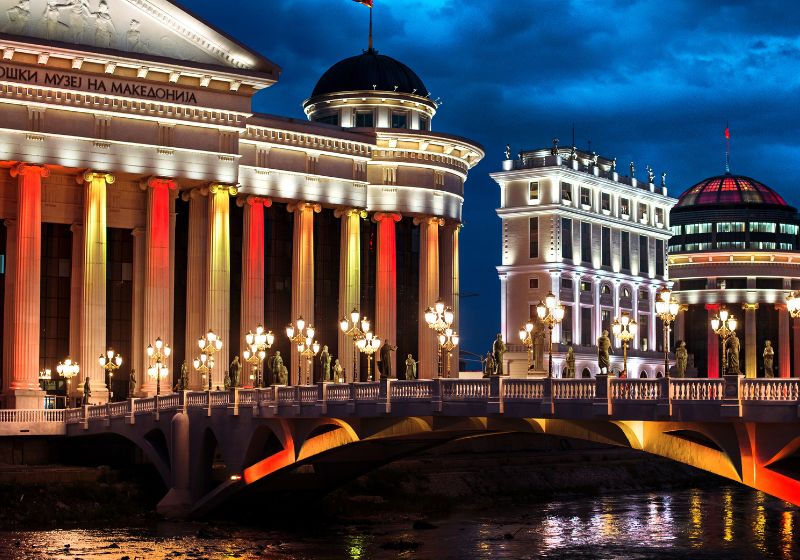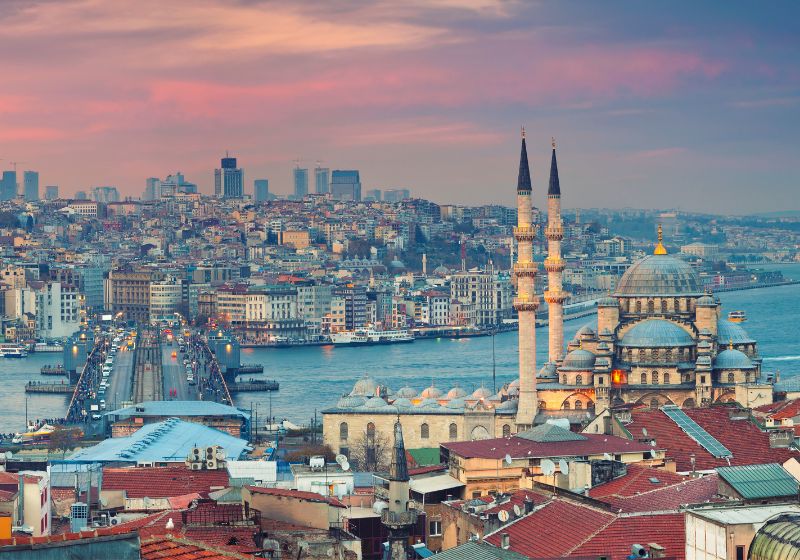Skopje and Istanbul are two vibrant and diverse cities with rich histories and cultures.
Located not too far from each other, these cities offer a range of experiences for travelers, from iconic landmarks and delicious cuisine to vibrant festivals and a rich cultural heritage.
But what are the key main differences between Skopje and Istanbul?
In this article, we will explore some of the key distinctions between these two cities, including their location, population, history, cultural attractions, and more.
By understanding the unique characteristics of Skopje and Istanbul, you can decide which destination is the best fit for your travel plans.

How Does Skopje Compare To Instanbul?
| Skopje | Istanbul | |
|---|---|---|
| Location: | Southeastern Europe (Balkans) | Western Asia and southeastern Europe (straddling the Bosporus Strait) |
| Population: | Around 750,000 | Over 15 million |
| Language: | Macedonian | Turkish |
| Currency: | Macedonian denar (MKD) | Turkish lira (TRY) |
| Climate: | Humid subtropical (hot summers, cold winters) | Humid subtropical (hot and humid summers, mild winters) |
| Major landmarks: | Kale Fortress, Museum of the City of Skopje, Memorial House of Mother Teresa | Hagia Sophia, Blue Mosque, Grand Bazaar, Topkapi Palace |
| Famous events and festivals: | Skopje Jazz Festival, Skopje Summer Festival, Skopje Design Week | Istanbul International Film Festival, Istanbul Biennial, Istanbul Music Festival |
| Popular activities and things to do: | Visit the Museum of the City of Skopje, explore the Kale Fortress, and try local cuisine at a Skopje market | Visit the Hagia Sophia and the Blue Mosque, shop at the Grand Bazaar, and take a cruise on the Bosporus Strait |
Location:
Skopje is located in the Balkans region of southeastern Europe, while Istanbul is located in western Asia and southeastern Europe, straddling the Bosporus Strait.
Language:
The official language of Skopje is Macedonian, but many people in the city also speak English, especially in the tourism industry.
In Istanbul, the official language is Turkish, and just like in Skopje, many people also speak English.
Currency:
The currency in Skopje is the Macedonian denar (MKD) while in Istanbul, they use the Turkish lira (TRY).
Wherever you decide to visit, it is a good idea to exchange some money or obtain cash from ATMs upon arrival.
Credit cards are widely accepted in both cities, but it is always a good idea to have some cash on hand for smaller purchases or in case of emergencies.
Population:
Istanbul is a much larger city than Skopje, with a population of over 15 million people compared to around 750,000 in Skopje.
Climate:
Both Istanbul and Skopje have a humid subtropical climate, with hot and humid summers and cold winters.
The best time to visit depends on your preference, but the spring and fall months (April to May and September to October) are generally considered the most pleasant, with moderate temperatures and fewer crowds.
History:
Both Skopje and Istanbul have rich histories, and they have been influenced by mostly similar cultures and empires over the centuries.
Skopje has been influenced by a range of civilizations, including the Romans, Byzantines, and Ottoman Turks, among others.
Istanbul, with a history that spans more than 2,500 years, and it has been influenced by a variety of cultures, including Greek, Roman, Byzantine, and Ottoman.
Transportation:
Istanbul has a well-developed transportation system, with a modern airport, a comprehensive network of buses, metros, and trains, and a large fleet of taxis.
There are also numerous ferries that connect the European and Asian sides of the city.
On the other hand, Skopje has a limited public transportation system, with a few bus and trolley bus lines that serve the city.
Taxis are readily available and are a convenient way to get around, but it is always a good idea to agree on a price before starting your journey.
Safety:
Both Istanbul and Skopje are considered to be safe cities to visit, and crime levels in both are low.
However, it is always a good idea to be cautious and take the same precautions you would in any other city, such as keeping an eye on your belongings and avoiding walking alone in deserted areas at night.
Cultural customs:
Both Instanbul and Skopje are highly religious and conservative cities it is a good idea to familiarize yourself with local customs and traditions before visiting to be respectful to the locals.
Cultural attractions:
Both Skopje and Istanbul have numerous cultural attractions, but they have their own unique character and offer a range of different experiences.
Skopje has a number of museums, galleries, and landmarks that reflect the city’s diverse influences, including the Museum of the City of Skopje, the Memorial House of Mother Teresa, and the Kale Fortress.
Istanbul, on the other hand, is home to a number of iconic landmarks and cultural attractions, including the Hagia Sophia, the Blue Mosque, the Grand Bazaar, and the Topkapi Palace.
Food and cuisine:
Both Skopje and Istanbul have rich and varied culinary traditions, but the types of food and dishes available in each city are different.
Skopje is known for its hearty and flavorful dishes that reflect the city’s diverse cultural influences, including burek (a savory pastry), ajvar (a roasted red pepper spread), and tavče gravče (a bean and vegetable stew).
Istanbul, on the other hand, is known for its diverse and delicious cuisine, with a range of dishes influenced by Turkish, Greek, and other Mediterranean flavors, such as kebabs, meze (a selection of small dishes), and baklava (a sweet pastry).
The Pros & Cons of Visiting Each City

Here are some potential pros and cons of visiting Skopje and Istanbul for tourists:
Skopje Pros:
Relatively inexpensive: Skopje is generally a more affordable destination than Istanbul, with lower prices for accommodation, food, and other tourist expenses.
Rich history and culture: Skopje has a rich and varied history, with numerous cultural attractions and landmarks that reflect the city’s diverse influences.
It’s a good starting point for exploring North Macedonia and the Balkans: Skopje is a convenient base for exploring other parts of Macedonia and the Balkans, with easy access to a range of destinations in countries such as Kosovo, Montenegro, and Albania.
Skopje Cons:
Limited transportation options: Skopje has a relatively small airport with limited international flights, which can make it difficult to reach for some travelers.
The city also lacks a comprehensive public transportation system, which can be a challenge for tourists who rely on buses and trains to get around.
Limited nightlife: While Skopje has a vibrant cultural scene, it lacks the nightlife options of larger cities like Istanbul, with fewer bars, clubs, and restaurants open late.
Istanbul Pros:

Rich history and culture: Istanbul is a city with a long and storied history, with numerous cultural attractions and landmarks that reflect its unique blend of Eastern and Western influences.
Good transportation options: Istanbul has a well-developed transportation system, with a modern airport and a comprehensive network of buses, metros, and trains that make it easy to get around the city.
Vibrant nightlife: Istanbul is known for its lively nightlife, with a range of bars, clubs, and restaurants that stay open late.
Istanbul Cons:
More expensive: Istanbul is generally more expensive than Skopje, with higher prices for accommodation, food, and other tourist expenses.
Crowded and chaotic: Istanbul is a large and busy city, and it can be overwhelming for some visitors, with heavy traffic, crowded streets, and a frenetic pace of life.
Political and social tensions: Istanbul has a history of political and social tensions, and it can be affected by demonstrations and other events that may disrupt travel or create a sense of unease for visitors.
READ NEXT: Skopje vs Belgrade: Which City Comes Out on Top?
This guide was first published on December 18, 2022 and was last updated on March 15, 2024. For more information, please contact us at contact@skopjeguide.com.